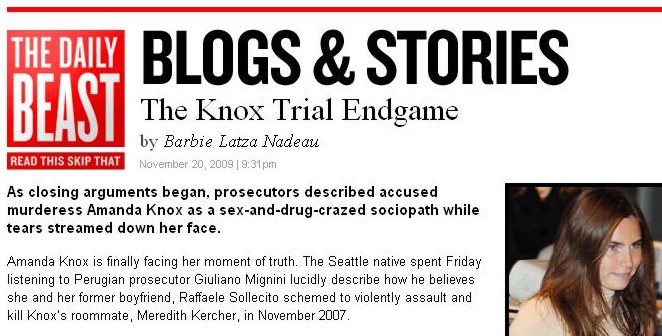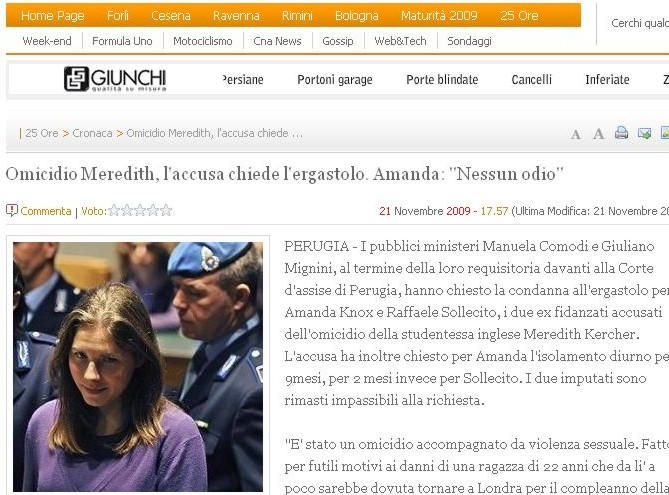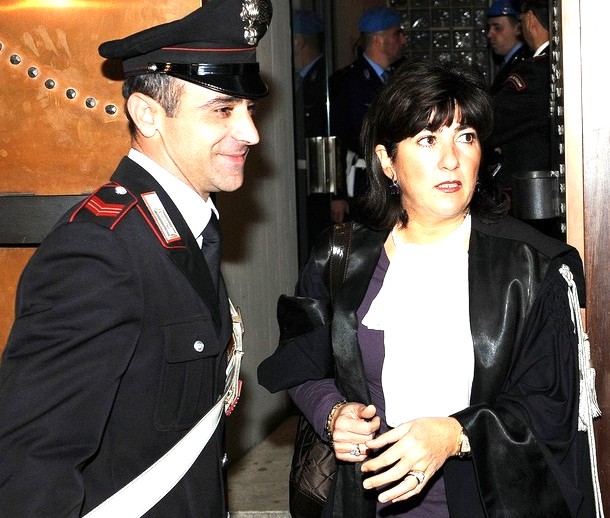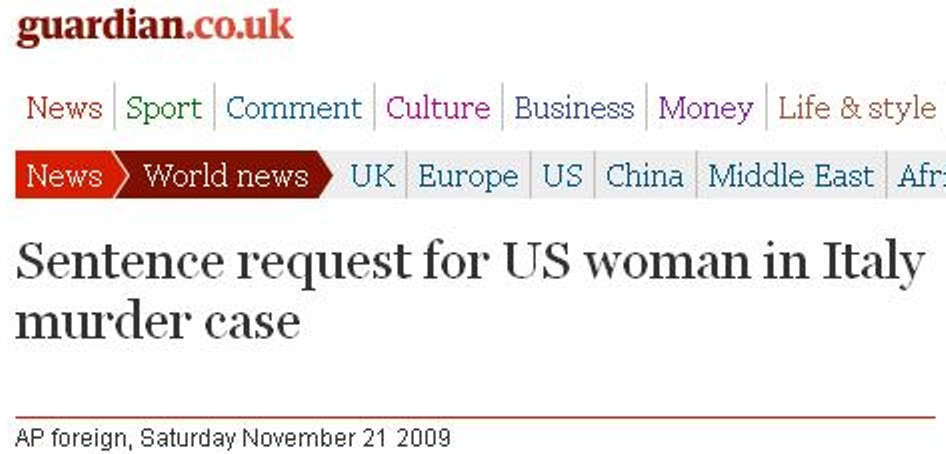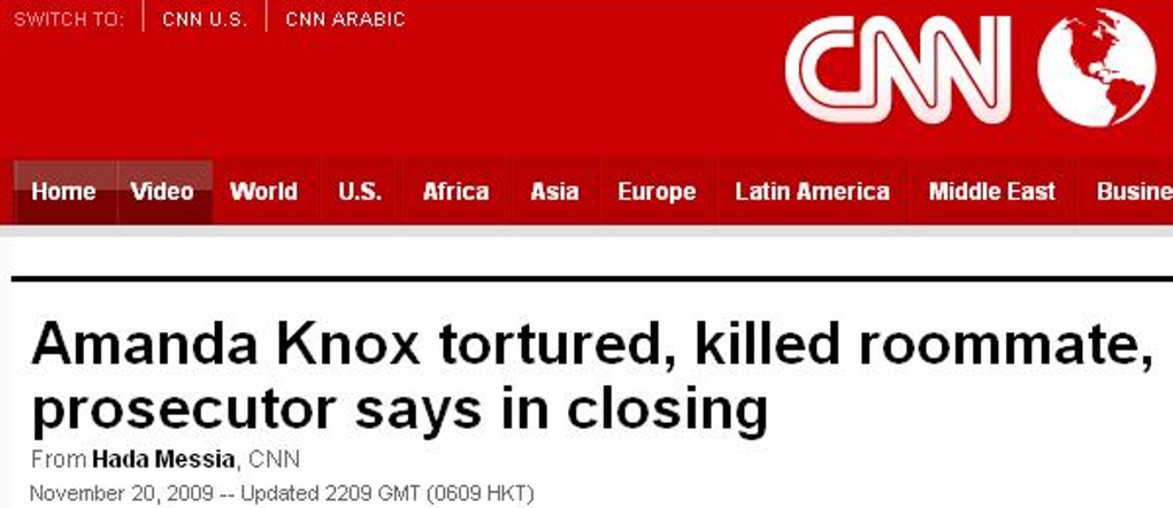
Category: Massei prosecution
Saturday, November 21, 2009
The Summations: Barbie Nadeau On Mr Mignini Setting Out The Attack Scenario
Posted by Peter Quennell
Click above for Rome-based Barbie Nadeau’s report from the courtroom. Her excellent description includes this sad passage on Meredith.
Then he described Kercher as a woman full of life and potential, “the young woman we too often forget.” Mignini quoted Kercher’s father John on a number of occasions, especially when explaining that she was a strong woman who practiced karate and who would have fought back against an attack.
The courtroom was silent as he recalled the words of Kercher’s father: “Meredith would have fought with all her life.”
The report also includes this on possible hard drugs.
He also hinted that Knox and Sollecito might have been in a drug-fueled frenzy when they allegedly killed Kercher. He outlined the effects of cocaine and acid, and told the judges and jury how Knox and Sollecito ran with a crowd that often used these “stupificante,” or stupefying drugs.
Drugs were not proven other than that both Knox and Sollecito claimed to have smoked marijuana on the day. The two drugs mainly hypothesized up to now if there was a drug other than unmodified marijuana (cannabis) seem to have been crystal meth and skunk cannabis.
Both of them are now proving a cause of psychotic episodes which can result in fatal attacks. Genetically-engineered skunk cannabis seems to increasingly be most of the cannabis on the market.
The Summations: The Italian Press Is Now Reporting Life Sentences Are Requested
Posted by Peter Quennell
Click above for Romana Oggi’s report in Italian. A translation:
Prosecutors Manuela Comodi and Giuliano Mignini at the end of their indictment before the Court of Assizes of Perugia requested a life sentence for Amanda Knox and Raffaele Sollecito, the two former lovers accused of the murder of British student Meredith Kercher.
The prosecution also asked for a period in isolation for Amanda Knox during the day for 9 months, and a period in isolation for Raffaele Sollecito during the day for 2 months.
The two defendants remained impassive to the request.
“This was a murder accompanied by sexual violence which was done for petty reasons against a girl 22 years old who was soon due to return to London for the birthday of her mother’’ Prosecutor Mignini said at the end of the indictment.
After he concluded, Amanda Knox stood up to make a brief statement spontaneously. “Meredith was my friend, and I did not hate her. The idea that I wanted revenge on a person who was always kind to me is absurd.”
“I never had any acquaintance or relationship with Rudy Guede. The things that were said in the past two days are pure fantasy. It is not the truth and not the reality of the situation.”
Meredith’s mother was far from well at the time, which was why Meredith was carrying two mobile phones (the two removed while she lay dying, presumably so she could not call for help) to be quite sure they could reach one another.
Meredith had been planning the trip home to London for weeks and was excited about it. It would have been her first trip home to see her family since she arrived in Perugia.
In June Meredith’s father John Kercher described how he found out Meredith would never come home.
The Summations: Manuela Comodi Continues The Prosecution’s Very Hard Line
Posted by Tiziano
Wow! This summation is quite remorseless.
Both prosecutors seem to have very deep feelings for Meredith, and much contempt for those who have tried so hard to deny her justice.
And they both seem very, very sure of their case - always remember that the judges and jury have seen a LOT of evidence in those 10,000-plus sealed pages and those many closed court sessions that we the public were not party to.
La Nazione reports now some more of Ms Comodi’s summing-up this morning. She was neatly tying the many elements together, and denying that anything at all is weak. .
PM Comodi: “The DNA was not contaminated”
The Magistrate opened her summing-up declaring that the proof which has emerged from the investigations is “irrefutable and overwhelming”. Speaking this morning was PM Manuela Comodi who began her summing-up by declaring that the proof emerging from the investigations was “irrefutable and overwhelming”.
The magistrate underlined that no right of the defence had been harmed, “The only right offended ““ Comodi said - was that of the scientific police and the postal police to see their work recognised.”
The PM defined the possibility of contamination of the DNA removed from the scene of the murder as “nil.
“In every biological analysis ““ she added ““ the risk of deterioration and contamination is inherent. Patrizia Stefanoni, the biologist of the scientific police has however put in action all the due procedures to avoid these phenomena and nobody can affirm the contrary. The consultants for the parties then took part in all the inspections and analyses.”
The Summations: First Report On Technical Summing-Up By Prosecutor Comodi
Posted by Tiziano
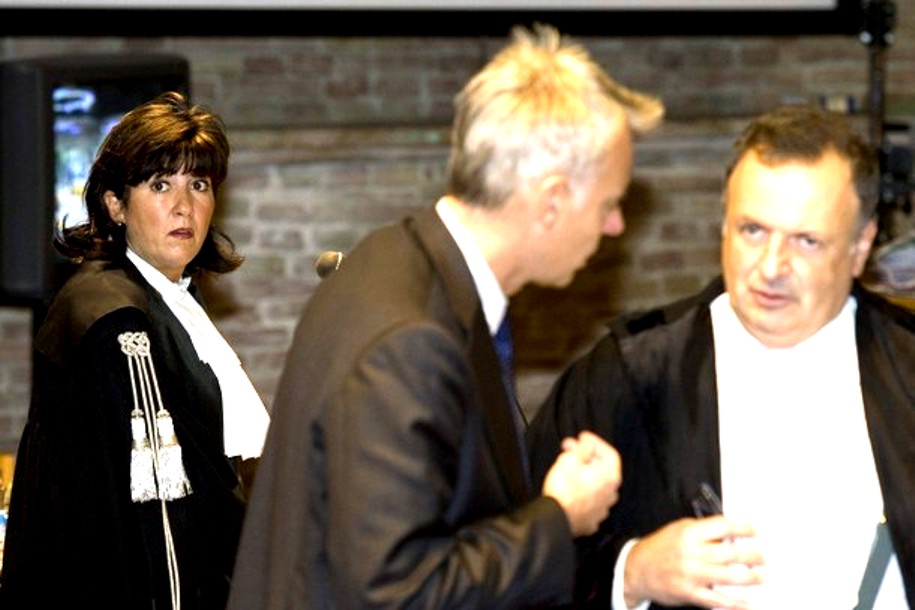
[Prosecutor Comodi this morning at left with defense lawyers Della Vedova and Maori]
Corriere is reporting the start of the summation by Manuela Commodi of the technical aspects of the case. A translation:
Meredith Trial, the PM speaks: “Irrefutable proof from the investigations”
It was Assistant Prosecutor Manuela Comodi to take the floor and she dealt with the scientific aspects of the investigation.
Manuela Comodi started her summing-up this morning by underlining that the rights of the defence had not been damaged….
“Irrefutable and overwhelming scientific proof” is what has emerged from the investigations. PM Manuela Comodi started her address in this way, stressing that no rights of the defence had been injured.
“The only right which has been offended” Comodi said “was that of the scientific police and the postal police to see their work recognised.”
Then the PM began to speak about the data relative to the telephone cells examined during the investigation.
[Next] it will be the turn of PM Mignini to speak again to make the request for the sentencing.
The Summations: AP’s Marta Falconi Is Reporting Life-In-Prison Request Is Expected
Posted by Peter Quennell
Click above for Marta’s report as carried in today’s Guardian. Some excerpts:
Prosecutors on Saturday were expected to request life in prison for an American student and her former boyfriend accused of killing a young British woman in Italy….
In her closing remarks Saturday, prosecutor Manuela Comodi said evidence presented during the trial had shown that the defendants’ cell phones were switched off the night of the crime, making their whereabouts impossible to trace.
Comodi also recalled testimony by expert witnesses who said Sollecito’s computer had not been used during the hours Kercher was stabbed to death.
Prosecutors were expected to make the sentencing requests later Saturday. A verdict is expected in early December.
The Summations: Perenially Fact-Challenged CNN Reports On Today Correctly
Posted by Peter Quennell
Click above for CNN’s report by Hada Messia.
CNN of course broadcast the notorious Larry King interview with lawyer John Q Kelly and the equally notorious legal screaming-match chaired by Jane Velez Mitchell. The YouTubes of both have been quietly disappeared. And all of its online reports on the case seem to contain bias and errors.
CNN gas been periodically updating this report of Hada Messia for some days, though it still contains wrong statements. The brief new component on today’s proceedings is in fact relatively accurate.
Accompanied by two smitten young men vying to impress her, a resentful Amanda Knox toyed with a knife and then plunged it into her roommate’s neck, killing her, an Italian prosecutor charged in closing arguments Friday.
The November 2, 2007, death of British student Meredith Kercher occurred during a twisted sex game in which Knox taunted Kercher, and the two men—boyfriend Rafael Sollecito and acquaintance Rudy Guede—sexually assaulted her, prosecutor Guilano Mignini said during his seven-hour closing.
The prosecutor said Knox hated and resented Kercher and had decided the time had come to exact revenge…. Mignini said Kercher died about 11:30 p.m. after she and Knox had quarreled—either over money or Guede’s presence at the house.
The prosecutor said the men pinned Kercher down by her arms while Knox played with the knife, prodding at her throat and saying, “Ah, you were pretending to be such a little saint. ... Now we are going to show you.”
Francesco Maresca, a lawyer for the Kercher family, said he was “very satisfied” with the prosecutor’s argument, adding that the crimes should bring a life sentence.
Friday, November 20, 2009
The Summations: More On How The Prosecution Launched Forth - And On Possible Motive
Posted by Tiziano

[Above: The two prosecutors today - click for larger image]
The TGCOM news service quoted this statement on the theory of the motive.
“Amanda Knox harbored hatred for Meredith… and so it was time for revenge rather than flirting….” According to the prosecutor Amanda wanted revenge on “that girl who was only with her English friends, and who reproached [Amanda] for her lack of cleanliness.” Thus was set under way “the calvary of Meredith.”
And this report from Umbria Journal adds details to the description posted below from Il Mattino
PM Giuliano Mignini spoke of a “unique event” of a trial which has “involved three continents”, opening his summing-up address in the trial of Raffaele Sollecito and Amanda Knox.
“A media trial in which the elements which emerged in court largely vanished,” the magistrate affirmed. “Detectives in search of notoriety, writers, bloggers, and mystery writers alternated with one another in a sort of parallel trial. But the trial is taking place only in this court room.”
Rudy Guede has been the “convitato di pietra” [literally, silent guest] in the trial of RF and AK according to Mignini. “In a way he has always been present,” the magistrate said referring to the Ivorian, already condemned to 30 years in prison by fast-track trial for complicity in the murder of Meredith Kercher with the two young people.
“Supporters of Sollecito and Knox” Mignini stressed “don’t stop at proclaiming their innocence, but they accuse him [Guede] too. They say that they were not at the crime house, but they also say the assassin is Guede. The accused wanted to create a parallel trial without his being able to defend himself.”
The PM then claimed that the breaking of a window in the bedroom of one of the Italian housemates of Knox and Meredith Kercher carried out according to the prosecution to mislead the investigations “is the special key to the event and the mystery. If it was simulated, as is evident, the authors are Knox, and Sollecito who always followed her. And the objective was to turn away suspicion.” The magistrate defined the break-in as “the nail on which the defences of the accused are hanging.”
“A nail” he averred “which has fallen down noisily and with it the the defences.” For Mignini the theft was simulated “from the inside, by someone who wanted to turn away suspicions and maybe direct them towards Rudy.”
Amanda Knox “knowingly accused an innocent man”... The reference is to Patrick Lumumba who, however, he did not expressly name, involved in the investigations of the murder of Meredith Kercher through the statements to the police of the young American and then absolved of any wrong-doing (he has actually nominated as a civil complainant against the American who is accused of defamation against him).
“Amanda” the [prosecutor] stressed “did not lift a finger while he was languishing in prison. Neither she nor her mother who was in her confidence. And what a coincidence” Mignini continued “it was a matter of a coloured person like Rudy”
Monday, October 12, 2009
Case For The Prosecution: #5 Defendants’ Claims Shown As Mass Of Contradictions
Posted by The Machine

[Above: Perugia’s central police station]
Preamble
This series is a summary of the prosecution’s case in about ten parts, with a commentary on matters of key significance.
The material has been reordered so that evidence presented at several points in the trial can be described in one post here. Sources used are the many published reports, some transcripts made of the testimony and the mobile phone records of Amanda Knox and Raffaele Sollecito.
The first four posts were on the DNA evidence, the luminol-enhanced footprint evidence, and Raffaele Sollecito’s and Amanda Knox’s various conflicting alibis.
Now we look at the many contradictory statements of Amanda Knox and Raffaele Sollecito brought out by the prosecution.
The prosecution showed that not only are they contradicted by one another. They are contradicted by telephone and computer records, by closed-circuit TV footage, and by the corroborated testimony of several witnesses.
One question that Judge Massei and Judge Cristiana and the six members of the jury will now be asking themselves is: if Amanda Knox and Raffaele Sollecito are innocent and had nothing to hide, why did they lie so repeatedly?
Knox’s and Sollecito’s lawyers have had the unenviable task of trying to explain all their contradictions away.
Sollecito’s lawyers have argued that he lied out of confusion and fear. Knox’s lawyers have argued that she dramatically changed her version of events because she was hit and mistreated by the police on 5 November 2007. Neither of these claims stood up to close scrutiny.
And the prosecution made it overwhelmingly apparent to the judges and the jury that Knox and Sollecito each lied deliberately and repeatedly to various people even before they were suspects and even before Knox was questioned on 5 November.
It was made intensely obvious that Knox and Sollecito’s versions of what they did on 1 November had very little in common with each other, especially in that part of the evening when they both claim they couldn’t remember very much because they were suffering from cannabis-induced amnesia.
There is no convincing scientific evidence that shows that cannabis can cause such dramatic amnesia. Skunk cannabis can cause extreme psychotic episodes and murders have occurred as a result. Long term use of cannabis can affect short-term memory and users might have difficulty recalling a telephone number. But wipe out whole chunks of an evening from anyone’s memory banks? The proof simply isn’t there.
1-A) The afternoon of 1 November 2007 according to Raffaele Sollecito
Sollecito told investigators that Knox and he had left the cottage on Via della Pergola at 6.00pm and that they went for a walk downtown. They passed through Piazza Grimana, Piazza Morlacchi and the main fountain in Corso Vannucci.
1-B) The afternoon of 1 November 2007 according to Amanda Knox
Knox told investigators it was an hour earlier at 5.00pm and that they went straight to Sollecito’s apartment.
2-A) The evening of 1 November 2007 according to Raffaele Sollecito
Raffaele Sollecito first claimed in an interview with Kate Mansey from the Sunday Mirror that he and Amanda Knox were at a friend’s party on the night of the murder.
Sollecito said that he downloaded and watched the film Amelie during the night. However, computer expert Mr Trotta said that the film had actually been watched at around 6.30 pm.
On 5 November Sollecito told police that Knox went to meet friends at Le Chic at around 9pm and that she didn’t return until about 1am:
“At 9pm I went home alone and Amanda said that she was going to Le Chic because she wanted to meet some friends. We said goodbye. I went home, I rolled myself a spliff and made some dinner.”
Sollecito claimed that he had spoken to his father at 11pm. Phone records show that there was no telephone conversation at this time. Sollecito’s father had called him a couple of hours earlier at 8.40pm.
Sollecito claimed that he was alone and surfing the Internet from 11pm to 1am. No technical evidence of this was introduced. computer specialists have testified that his computer was not used for an eight-hour period on the night of Meredith’s murder
The Kercher’s lawyer, Franco Maresca, pointed out that credible witnesses had really shattered all of Sollecito’s alibi for the night of the murder.
2-B) The evening of 1 November according to Amanda Knox
Amanda Knox told the police that she hadn’t replied to Diya Lumumba’s text message. The police knew full well that this wasn’t true because they already had her mobile phone records that proved that she had texted him.
“After that [finding out she wasn’t required at Le Chic] I believe we relaxed in his room together, perhaps I checked my email.” But no internet activity at all was proven at Sollecito’s apartment beyond the early evening.
“One thing I do remember is that I took a shower with Raffaele and this might explain how we passed the time. In truth, I do not remember exactly what day it was, but I do remember that we had a shower and we washed ourselves for a long time. He cleaned my ears, he dried and combed my hair.”
But Sollecito made no mention of taking a shower with Amanda Knox on the night of the murder.
In Amanda Knox’s handwritten note to the police she claimed that she and Sollecito ate around 11.00pm:
“One of the things I am sure that definitely happened the night on which Meredith was murdered was that Raffaele and I ate fairly late, I think around 11 in the evening”
But Knox testified at the trial that she and Sollecito ate around 9.30pm. “After we ate Raffaele washed the dishes but the pipes under his sink broke and water flooded the floor.”
3) The early hours of 2 November
Both Knox and Sollecito claim that they woke up late on 2 November. However, their mobile phone records show the mobiles were turned on at approximately 6.02am. Sollecito also used his computer at 5.32am. The Italian Supreme Court remarked that his night must have been “sleepless” to say the least.
4) The afternoon of 2 November
At 1208pm, Amanda Knox called Filomena and said she was worried about the front door being open and blood stains in the small bathroom. Knox claims that she made this call from Sollecito’s apartment.
However, in his prison diary, Raffaele describes the same conversation as taking place at the cottage.
Knox claimed that when she called Meredith’s Italian phone it “just kept ringing, no answer”.
Her mobile phone records show this call lasted just three seconds, and the call to the UK phone lasted just four seconds. (Meredith’s WeAnswer Call service, which prides itself on how quickly it answers its customers’ calls, boasts that their average speed-of-answer is 5.5 seconds. There were no messages left.)
At 12.34pm Amanda and Filomena again spoke on their phones. Filomena said, “We spoke to each other for the third time and she told me that the window in my room was broken and that my room was in a mess. At this point I asked her to call the police and she told me that she already had.”
The prosecution introduced records to show that Knox and Sollecito didn’t actually call the police until 12.51pm.
In her email to friends in Seattle on 4 November, Amanda Knox says she called Meredith’s phones after speaking to Filomena. Knox’s mobile phone records prove that this was untrue.
In the email, Amanda also claims that she called Filomena back three quarters of an hour later ““ after Raffaele finished calling the police at 12:55pm. But cellphone records show that Knox never ever called Filomena back at all.
Sollecito and Knox both claimed they had called the police before the postal police had turned up at the cottage and were waiting for them. Sollecito later admitted that this was not true, and that he had lied because he had believed Amanda Knox’s version of what had happened.
He said he went outside “to see if I could climb up to Meredith’s window” but could not. “I tried to force the door but couldn’t, and at that point I decided to call my sister for advice because she is a Carabinieri officer. She told me to dial 112 (the Italian emergency number) but at that moment the postal police arrived.
He added: “In my former statement I told you a load of rubbish because I believed Amanda’s version of what happened and did not think about the inconsistencies.” (The Times, 7 November, 2007).
The CCTV cameras in the car park record the arrival of the postal police at 12.25pm which corroborates Sollecito’s admission that he had spoken rubbish.
Knox’s email to friends in Seattle describes the decision to call the police as something implemented by herself and Sollecito, after she had tried to see through Meredith’s window, and after Raffaele had tried to break down Meredith’s door.
Knox’s mobile phone records show that she called her mother at 12:47pm, but she makes no mention of this call in her email. (This call was very extensively analysed by fellow poster Finn MacCool and he showed a fascinating progression in both Amanda’s and her mother’s recollection of that call.)
Edda Mellas claims that she told Amanda to hang up and call the police ““ but Amanda made no mention of this advice from her mother in describing their decision to call the police.
Amanda Knox testified that she couldn’t even remember phoning her mother, which will be very difficult for the court to believe. Phoning her mother when it is well after midnight in Seattle to tell her mother that she thought somebody had broken into her home and that her housemate was missing seems an unlikely thing to forget.
Amanda Knox told the postal police that Meredith always kept her door locked. Filomena strongly disagreed with her, and told the postal police the opposite was true.
The prosecution also made it obvious to the court that Amanda Knox and Raffaele Sollecito, like Rudy Guede, changed their stories to fit new facts as they became known:
When Sollecito was confronted with the mobile phone records on 5 November, he immediately admitted that they hadn’t called 112 before the postal police arrived.
After initially denying it, Knox readily admitted that she was at the cottage when Meredith was killed when she found out that Sollecito had stopped providing her with an alibi.
Despite this changing of their stories to take into account the latest known facts, Knox’s and Sollecito’s versions still contained numerous contradictions. Sollecito’s final alibi contains several apparent lies, and Amanda Knox accused Diya Lumumba of killing Meredith while making no mention of Rudy Guede.
In Conclusion
The reasons Amanda Knox’s and Raffaele Sollecito’s lawyers have given for them lying - namely false memories, confusion and fear ““ seem very unlikely to fly with the court.
Repeated evidence was introduced to show that Meredith’s other flatmates and friends all behaved radically differently, and told what were obvious truths that matched up repeatedly and resulted in not a single major contradiction. All were checked out in this careful fashion and then allowed to go on their way.
Only the defendants’ claims failed to coincide or match with everything else.
Again, and again, and again.
Thursday, October 08, 2009
Newsweek’s Barbie Nadeau Has A Really Vital Piece On How The Evidence Stacks Up
Posted by Peter Quennell
And, in short, it is ominous.
Click above for the full report. This really IS vital reading. A few key excerpts as follows.
Evidence: Rudy Guede
Who it hurts: Knox and Sollecito
Rudy Guede is the 24-year-old Ivory Coast native convicted in a fast-track trial last October for his role in Kercher’s murder. He is serving a 30-year sentence (his appeal begins on Nov. 19). Guede, who refused to testify in the Knox trial, has admitted that he was in the house when Kercher was killed. He says Kercher invited him there and that the two were making out when a stomach cramp from a bad kebab sent him to the bathroom. He was on the toilet with his iPod headphones on through four songs and, when he came out, Kercher was dying. He says he tried to save Kercher by using a towel to sop up the blood on her neck wounds, but he was scared after a man he says looked like Sollecito told him that “they’ll pin this on the black guy.” Guede fled to Germany, where he was later arrested for skipping a train fare. His feces (found in a toilet), along with his DNA and fingerprints from Kercher’s bedroom, link him to the crime scene. The sentencing judge who convicted him, though, did not see him as a lone assailant. Instead, the judge wrote in his sentencing report that he believed Guede acted with Knox and Sollecito.
Evidence: Murder dynamic
Who it hurts: Knox and Sollecito
One of the most complicated aspects of Kercher’s tragic death is how the murder itself played out. The prosecution believes that Knox, Sollecito, and Guede taunted Kercher in a sex game that quickly escalated to violence and ended in murder. Countless forensic experts, including those who performed the autopsies on Kercher’s body, have testified that more than one person killed her based on the size and location of her injuries and the fact that she didn’t fight back””no hair or skin was found under her fingernails. The defense has confused matters more: Knox’s forensic specialist testified that Kercher had been killed by only one person from the front, but Sollecito’s expert testified that Kercher had been killed by one person from behind.
Evidence: Knox’s confession
Who it hurts: Knox
On Nov. 5, 2007, Sollecito was called to the Perugia police station for questioning about Kercher’s murder. Knox testified last June that she did not want to be alone, so she accompanied him. During his interrogation, Sollecito admitted to police that he did not know for sure if Knox actually spent the night of the murder at his house, as she had told police earlier. Since Knox was at the police station, the head of the murder squad decided to ask her a few questions. Her interrogation started at about 11 p.m., and, by 5:45 a.m., Knox had told police that she was in the house when Kercher died””and that Patrick Lumumba, the owner of the nightclub where she worked, was the assailant. She even described Kercher’s screams. She, Sollecito, and Lumumba were arrested. The next day, Knox wrote a five-page memorandum reiterating everything she said the night before. But since there was no lawyer present during her interrogation””and so far no one has produced an audiotape of the interrogation””Knox’s attorneys were able to have her verbal confession thrown out of evidence. The five-page memorandum still holds….
Evidence: Conflicting alibis
Who it hurts: Unknown
Knox maintains that she spent the night of Nov. 1, 2007, at Sollecito’s house. Sollecito did not take the stand during this trial, and his lawyer told NEWSWEEK that it was, at least in part, because he could not corroborate Knox’s alibi….
So Sollecito did not take the stand in part because he could not corroborate Knox’s alibi. Wow. That has to hurt.
Very much more in Barbie Nadeau’s original piece. We recommend that you read it all.
Wednesday, August 19, 2009
Case For The Prosecution #4: Amanda Knox’s Multiple Conflicting Alibis
Posted by The Machine
The Knox Alibis: How They Conflict
The first three posts on the power of the case were on the DNA evidence, the luminol-enhanced footprint evidence, and Raffaele Sollecito’s various conflicting alibis.
Now we look at the various conflicting alibis that Amanda Knox has given for the night in question. We dont yet have full transcripts and have to rely on what was reported in the UK press.
Please click here for more

